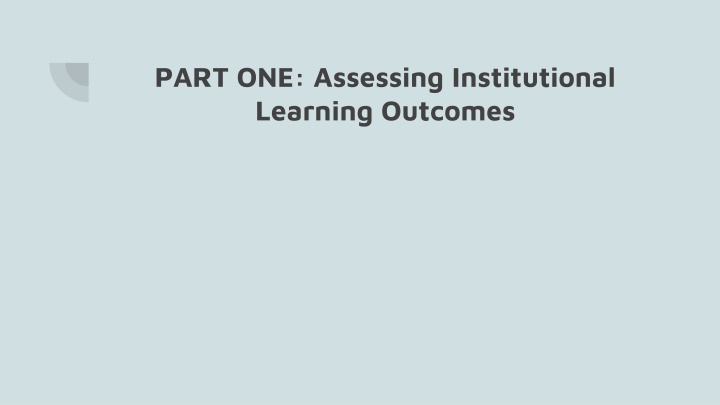
Assessing Institutional Learning Outcomes and Effective Communication Strategies
Explore methods such as surveys, embedded assignments, and cross-disciplinary approaches to assess and enhance institutional learning outcomes, focusing on effective communication skills in students across various courses and services.
Download Presentation

Please find below an Image/Link to download the presentation.
The content on the website is provided AS IS for your information and personal use only. It may not be sold, licensed, or shared on other websites without obtaining consent from the author. If you encounter any issues during the download, it is possible that the publisher has removed the file from their server.
You are allowed to download the files provided on this website for personal or commercial use, subject to the condition that they are used lawfully. All files are the property of their respective owners.
The content on the website is provided AS IS for your information and personal use only. It may not be sold, licensed, or shared on other websites without obtaining consent from the author.
E N D
Presentation Transcript
PART ONE: Assessing Institutional Learning Outcomes
courses and services support institutional outcomes EFFECTIVE COMMUNICATION. The ability of students to write, read, speak, and listen in order to communicate effectively. Students will be able to: Comprehend, interpret, and analyze written and oral information; Express ideas and provide supporting evidence effectively in writing and in speaking; Express ideas creatively through verbal and non-verbal media (e.g. music, art, dance, etc.) Communicate effectively in a group or team situation. ENGL 100 #2: Write text- based expository essays unified by a thesis and by an organizational strategy that reflect the assignment's task and purpose CHEM 220 #1: Demonstrate an understanding of the basic principles of chemical reactions and reaction processes through explanations and appropriate calculations. DENT 753 #1: Demonstrate the ability to communicate professionally & effectively with patients and the dental team ART 206 #4: Describe, interpret and assess their own artwork and that of their peers and professional artists.
example: august flex activity (common rubric) Flex day Fall: Discussion - Effective Communication: What do we have in common? Tailoring a rubric (with faculty from English, Dental Assisting, Chemistry and Business) criteria for good activity: offers a fresh perspective on student learning generates meaningful discussion End of Fall: Participating faculty grade students using the common rubric; submit results to SLOAC connects back to teaching in a practical way is easy for faculty to participate in Beginning Spring: Follow-up discussion: What did faculty get out of the experience? Any ideas for follow- up? (collaborations, tweaks etc.) ___ helps students reflect on their learning
surveys method: Survey students to see how they rate their proficiency. what sort of questions should we ask? who should take the survey? what are we trying to find out? what won t this method tell us? what discussion or action might arise from the results?
embedded / tagged assignments embed or tag assignments at the course level which gauge student proficiency in an institutional learning outcome. should we create cross-disciplinary assignments? or blueprints for an ILO -relevant assignment? will this create extra work for faculty? which courses should we target? what are we trying to find out? what won t this method tell us? what discussion or action might arise from the results?
shared rubrics Use a common rubric, related to a specific ILO, to assess student work in different disciplines. what s the best way to develop this rubric? will this create extra work for faculty? what are we trying to find out? what won t this method tell us? what discussion or action might arise from the results?
student activities / projects recruit students to participate in an activity, or submit a project or presentation, that reflects their overall grasp of institutional learning outcomes. what sort of activity? (discussion / portfolio / presentation?) how do we get students to participate? how do we get faculty to observe and assess? what are we trying to find out? what won t this method tell us? what discussion or action might arise from the results?
REFLECTION (10 minutes) Focus on one or two of the Institutional Learning Outcomes your course or service supports. Jot some responses down to the following questions: 1. Which ILOs matter most to your discipline or service area? 2. We all want students to apply what they learn with us to their wider academic and personal development. If you could assess students in the ILO-related skills outside your classroom, what would you want to know? (Don t get too abstract!)
